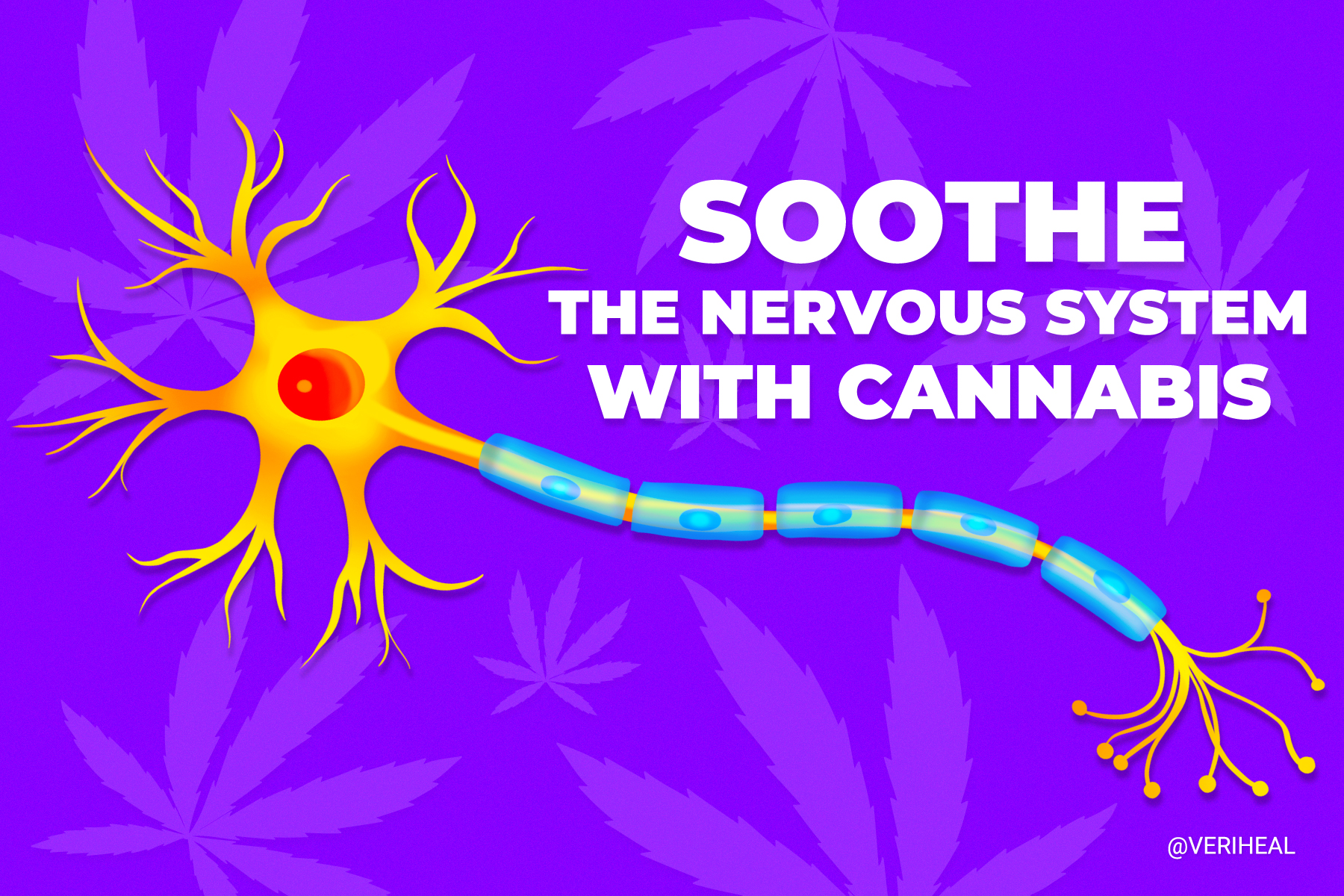The nervous system plays a large role in our functioning and mobilizes our actions. It can also be overstimulated, which can then impact sleep patterns, increasing anxiety levels and causing changes in behavior and abnormal sensations. A nervous system that is in disarray can mean there are additional triggers that one may not have had otherwise leading to being easily agitated, lowered pain thresholds, and even breakdowns.
Since the nervous system assists with the communication between all parts of the body and responds to changes inside and outside of the body, it is important to soothe and calm the nervous system. Let’s dive deeper and learn how to soothe the nervous system with cannabis.
How the Nervous System Works
The brain and spinal cord make up the Central Nervous System, meanwhile, the nerves located everywhere else are called the Peripheral Nervous System. As a whole, it all communicates with other parts of the body so it can function. It’s essentially the body’s electrical system that has three broad functions: sensory input, information processing, and motor output.
The main role of the peripheral nervous system is to “connect the CNS to the organs, limbs, and skin”. Which then allows the “brain and spinal cord to receive and send information to other areas of the body, which allows us to react to stimuli in our environment”. The central nervous system “plays a central role in the control of most bodily functions, including awareness, movements, sensations, thoughts, speech and memory” which is made possible by the fact that it is “connected to a section of the brain called the brainstem and runs through the spinal canal”.
For the sake of deepened understanding, you should know that the parasympathetic nervous system is responsible for “the body’s rest and digestion response when the body is relaxed, resting or feeding” and that it “basically undoes the work of sympathetic division after a stressful situation.” These two divisions of the nervous system fall under the “autonomic system” of the PNS. The autonomic system regulates involuntary body functioning.
Why It’s Important to Soothe the Nervous System
As you can see, the nervous system is integral to the functioning of the body and livelihood. When it’s negatively impacted or overstimulated, a ripple effect occurs that can ultimately have repercussions on our overall health.
A suggestion from Innis Integrative Therapy advises that “if our nervous system detects a threat, real or perceived, it will trigger our fight/flight/freeze response,” which can leave one feeling like they have no control over their disposition or even feeling a tightness in the chest. When your body experiences a threat, whether real or perceived, whether emotional or physical, the nervous system sets you into action. Once your body deems that you are safe, the parasympathetic nervous system “calms your body down.” However, what happens when “there isn’t a definitive end to the threat?”
Crossroads Centre explains that “when there isn’t a definitive end to a stressor or social connections haven’t been established to create calm, the body sometimes decides to ‘check out.’” Soothing the nervous system creates calm in the body and reduces the risk of becoming dissociative or developing PTSD when the nervous system is in disarray. The center also explains that, excluding some cases, addiction “is an attempt to self-soothe via dysfunctional means.” They go on to explain that when the body is experiencing a threat without a definitive end, it will “demand to be soothed by the drug of choice once again.”
Ultimately, it’s important to tend to and soothe your nervous system so that you can maintain control, reduce stress and anxiety, avoid dissociation, and minimize the risk of developing other health issues or even substance abuse as a means of self-soothing.
How You Can Calm the Nervous System With Cannabis
Based on the symbiotic relationship between cannabis and the endocannabinoid system, you could use cannabis to soothe the nervous system. The endocannabinoid system (ECS) has receptors all over the body, which is what the cannabis compounds (cannabinoids) bind to. The endocannabinoid system also has endocannabinoids, which are self-made neurotransmitters that the cannabinoids bind to within the ECS.
So, the cannabinoids bind to the endocannabinoids which are in the receptors and are also scattered around the nervous system. The ECS is responsible for promoting homeostasis (balance) in the body and this function is then boosted when cannabinoids bind to endocannabinoids. Since the endocannabinoids are scattered around the nervous system, it makes sense that we are able to benefit from improved sleep, reduced pain, and reduced anxiety when we use cannabis.
Cannabis can be consumed through a multitude of delivery routes and you can even target specific therapeutic cannabinoids for your needs. For instance, check out these suggested strains for anxiety, or even CBN, the cannabinoid that can help with sleep. When you find the right cannabis product that works for you, try and also include other calming methods that can help soothe your nerves, like yoga!
My Personal Experience Using Yoga Combined With Cannabis
During a yoga therapy course that I completed, I learned that when the body feels as though it is under threat, allostasis occurs – which is the internal system that enables the body to stabilize and energize enough to cope with the threat. During this process, the body is flooded with hormones that allow the body to move into the state of fight/flight/freeze. When the parasympathetic nervous system has regained control and calmed the body, the state is referred to as homeostasis.
As you can see, the homeostasis-promoting function of the ECS and the benefit of cannabis boosting that function can be a great way to self-regulate and soothe the nervous system. However, when you throw yoga into the mix, you will be able to maintain a state of homeostasis despite real/perceived or emotional/physical threats with seemingly no end.
During the course, the instructor explained that the three automatic states of a human being can be explained as follows:
- Hot (flight or fight)
- Cold (freeze, dissociation)
- Just right (homeostasis)
The instructor also placed emphasis on seeing all states in a positive light because they are all necessary for survival; which means that it is important not to let your state get you down. I know what you’re thinking, that it’s easier said than done. But with the right tools and practice, it can become easier. So, let’s equip you with the necessary tools to self-regulate and soothe your nervous system with the least pharmaceutical intake and risk and with the best efficacy.
How to Combine Yoga With Cannabis
I have found the therapeutic combination of yoga and cannabis to be second to none, which is why I felt the need to share this with you. Benefiting from this powerful duo is easy, just follow these simple steps:
- Reflect on your state and determine whether you are hot or cold.
- Make a commitment to yourself to remain consistent in your yogic practice. I would recommend doing yoga at least 3 times a week AND when needed- it doesn’t have to take long either).
- Prepare your low-moderately potent cannabis.
- Decide on the poses for your yogic flow and put out your mat.
- Put on music or sounds which make you feel happy or calm.
- Sit in a starting position and consume your cannabis.
- Go through your flow.
- End with some breathing, meditation, and/or positive affirmations.
Suggested Poses
Starting Poses
|
Poses for the Hot
|
Poses for the Cold
|
Breathing Exercises
|
- Easy pose/sukhasana
- Accomplished pose/siddhasana
- Gracious pose/bhadrasana
|
- Butterfly Melting heart
- Sleeping swan
- Cat tail
- Child’s pose
- Savasana Hero’s pose
|
- The sun salutation flow
- Cat-Cow
- Chair Pyramid
- Dancer Boat
- Thread the needle.
|
- Bee breath
- Straw breath
- Deep belly breathing
- Tree breath
- Candle breath
- Chop breath
- Peace breath
|
When you carry out your commitment to yourself, you will not only be able to self-regulate your body and promote homeostasis but you will also benefit from an array of physical benefits too. These include improvement in posture, mobility, strength, balance, coordination, and the list can go on. If you use cannabis for your nerves, we would love to hear your perspective and any suggestions you might have in the comment section below.
Author, Share & Comments
















